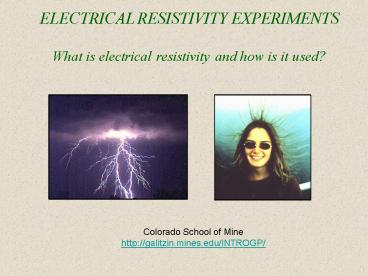ELECTRICAL RESISTIVITY EXPERIMENTS PowerPoint PPT Presentation
1 / 36
Title: ELECTRICAL RESISTIVITY EXPERIMENTS
1
ELECTRICAL RESISTIVITY EXPERIMENTS What is
electrical resistivity and how is it used?
Colorado School of Mine http//galitzin.mines.edu/
INTROGP/
2
Current Flow and Ohm's Law In 1827, Georg Ohm
defined an empirical relationship between the
current flowing through a wire and the voltage
potential required to drive that current.
Ohm found
that the current, I, was proportional to the
voltage, V, for a broad class of materials that
we now refer to as ohmic materials. The constant
of proportionality is called the resistance of
the material and has the units of voltage (volts)
over current (amperes), or ohms.
3
(No Transcript)
4
It's Resistivity, NOT Resistance The problem with
using resistance as a measurement is that it
depends not only on the material from which the
wire is made, but also the geometry of the wire.
If we were to increase the length of wire, for
example, the measured resistance would increase.
Also, if we were to decrease the diameter of the
wire, the measured resistance would increase. We
want to define a property that describes a
material's ability to transmit electrical current
that is independent of the geometrical factors.
5
(No Transcript)
6
Current Flow From Two Closely Spaced Electrodes
7
A Practical Way of Measuring Resistivity
8
Depth of Current Penetration Versus Current
Electrode Spacing
9
Wenner Array
Data point is located at the mid-point, at a
depth of about 50 of a.
10
Wenner Array (24 Nodes) Pseudosection
Data point location (N84)
Using the 24 electrode system, there are 7 levels
of data with a total of 84 data points as shown
above. Each data point is based on utilizing a
combination of 4 electrodes. From these data
points, a pseudosection is generated. A
pseudosection is a contour diagram of the
electrical resistivity values.
11
Electrical resistivity pseudosection
This is an example of an electrical resistivity
pseudosection for an area at the Rice Creek Field
Station. Dark and bright colors represent low
and high resistivity values respectively. Low
Clay-rich, water saturated (lt200
ohm-meters) High Sand-rich, boulders, water
undersaturated
12
During the Spring, 2006, the GEO 315 class
collected resistivity data at McIntyre bluff in
Cayuga County (next slide). Two sections were
collected within one of the erosional basins to
find the depth to the base of the near surface
groundwater. The pseudosections were
interpreted, and depth data was determined. The
depth data was plotted at the locations on the
field map and then contoured. Scroll through the
slides to see how this was done. For your
project, you will extract depth data for top of
the first shade of dark blue as shown with the
arrow in the image below. You must determine the
depth of this surface at an interval of 5 meters
for all four pseudosections (Line A, B, C D).
Plot the data (by hand) on the a print out of the
basemap, and then hand contour it.
Depth to this surface
13
McIntyre Bluff, Cayuga County, New York
14
(No Transcript)
15
(No Transcript)
16
(No Transcript)
17
(No Transcript)
18
McIntyre Bluff, Cayuga County, New York
19
Electrical Resistivity Survey Lines McIntyre
Bluff Earths Fury Class, Spring 2006
Sunday
Saturday
20
Electrical Resistivity Pseudosection McIntyre
Bluff Sunday, May 7, 2006
21
Electrical Resistivity Pseudosection McIntyre
Bluff Saturday, May 6, 2006
22
Scaled Pseudosection
Electrical Resistivity Pseudosection McIntyre
Bluff Saturday, May 6, 2006
23
Scaled Pseudosection
Electrical Resistivity Pseudosection McIntyre
Bluff Sunday, May 7, 2006
24
Electrical Resistivity Pseudosection McIntyre
Bluff Saturday, May 6, 2006 Taking into account
the local hill slope.
25
Electrical Resistivity Pseudosection McIntyre
Bluff Sunday, May 7, 2006 Taking into account
the local hill slope
26
Electrical Resistivity Pseudosection McIntyre
Bluffs Earths Fury Class, Spring 2006 Both
sections with the interpreted depth to the bottom
of the near surface groundwater (dash line)
27
Electrical Resistivity Survey Lines McIntyre
Bluff Earths Fury Class, Spring 2006
Sunday
Saturday
28
Delineation of Saturated vs. Under Saturated
Domains
The local elevations are shown. The top of the
hill is at 370 ft while the bottom is at about
250 ft.
250 ft
Saturated
Under Saturated
370 ft
29
370 ft
Electrical Resistivity Pseudosection McIntyre
Bluffs Earths Fury Class, Spring 2006 These
sections are shown with the relative elevations
A
B
250 ft
30
Schematic diagram of Line A relative to the
topography
370 ft
Ground surface
Bottom of shallow groundwater
250 ft
31
Blue arrows show the elevation of surface of
interest at a number of locations
Datum MSL
32
The red lines show the actual depth to the
surface of interest relative to the ground
surface.
33
Trace of resistivity lines with elevations of the
surface of interest. The elevation values were
determined from the interpreted resistivity lines.
250 ft
260
280
260
300
320
290
340
310
330
350
370 ft
34
Trace of resistivity lines with elevations of the
surface of interest. The elevation values were
determined from the interpreted resistivity lines.
250 ft
260
280
260
300
320
290
340
310
330
350
370 ft
35
Depth to the surface of interest from the ground
level.
250 ft
22.0
17.7
20.0
7.4
3.3
16.4
0
8.1
4.2
0
370 ft
36
Depth to the surface of interest from the ground
level (feet)
250 ft
22.0
17.7
20.0
8
20
7.4
4
3.3
0
16.4
0
16
12
8.1
4.2
0
370 ft

